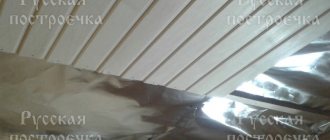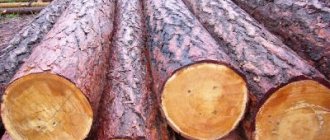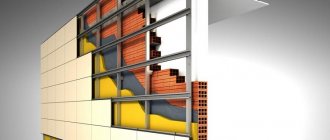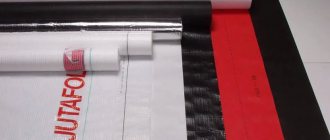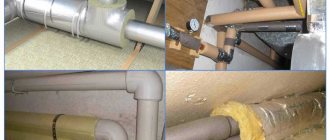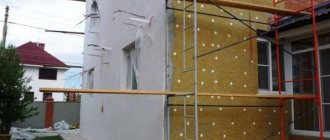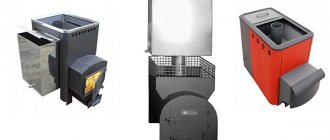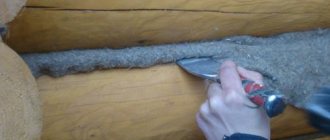Why do you need to line a bathhouse with foil?
Foil is one of the main materials in the construction of a bathhouse or sauna. It protects the room from the harmful effects of moisture. Bath foil is installed according to the “room within a room” principle, thereby achieving the effect of complete vapor barrier.
Foil reflects up to 98% of heat, which allows you to save on fuel. This is one of the required elements that are used in the construction of a bathhouse, steam room or sauna.
Additional properties of polystyrene foam with a foil layer
This material is combined and consists of polyethylene foam with a closed porous structure. It is supplemented with aluminum foil. The canvases are used as noise insulation and thermal protection material for interior and exterior work. The combination of these layers allows for economical and efficient finishing of baths and saunas. Among the main properties it is worth highlighting:
- shock-absorbing qualities;
- health safety;
- vapor barrier properties;
- ability to reflect heat up to 98%;
- long working life;
- chemical resistance.
Types of foil for baths
Construction foil can be simple or complex. The simplest foil is made in the form of a thin sheet of aluminum that wrinkles well. More complex options include ready-made insulation materials. The thickness of the insulation depends on the manufacturer. On average it is 1-30 centimeters.
Plain foil
The thickness ranges from 30 to 100 microns. One roll is enough to cover 12 square meters. meters. It is installed on a frame made of wooden beams. Under the foil there is mineral wool insulation. A sheet with a thickness of 100 microns can withstand temperatures up to 650° C.
Folgoizolon
Foamed polyethylene with foil coating. Sellers recommend this material as a universal remedy. Folgoizolon performs 3 functions at once: it insulates the room, reflects ultraviolet rays and creates sound insulation.
Has a large number of negative reviews. Consumers complain that foil isolon causes fires. It is highly flammable, and the operating temperature does not exceed 100° C. It has a thin layer of foil, which is sprayed onto the surface of polyethylene. Poorly maintains indoor temperature.
Folar
Sheet thickness ranges from 5 to 100 mm. Acts as insulation and moisture insulator. Mounted on a flat surface using glue. Reflects up to 97% of heat indoors. Capable of withstanding up to 300° C. Used without additional insulation.
Foil fabric (alu canvas)
It consists of two layers of foil between which is a layer of fiberglass fabric. Operating temperature 300° C. Sheet thickness from 1 to 3 mm. Foil fabric does not ignite during short circuits. It is resistant to damage and can even withstand knife cuts. Attached to the insulation using glue.
Paper based Kraft foil
Environmentally friendly material that can withstand temperatures up to 100°C. The sheet thickness is up to 1 mm. The composition of the sheet includes: aluminum foil, polyethylene and paper. Outwardly it looks like thin triplex, which is difficult to tear or cut.
Foiled polystyrene foam (foam)
Consists of a foam base and aluminum foil. Rarely used in baths because it has a high risk of ignition. The insulation properties are very mediocre. The foam quickly cools and loses heat, so in winter the bathhouse freezes very much. Used in apartments when installing heated floors.
How to insulate concrete floors
If you are completely confused by the wide range and do not understand what material to use, then take the advice of experienced builders. For example, with concrete floors it is recommended to use expanded clay.
No special preliminary preparation is required. For convenience, timber slats can be attached to the base of the roof. This will make it easier to check the uniformity of expanded clay distribution. Although this condition is advisory in nature.
So, pour expanded clay (30 cm thick) over the entire surface. An ordinary garden rake will help distribute the granules evenly. If the attic space will be used in the future and a floor is provided, then expanded clay is laid level.
If all the backfill is leveled, you need to lay the GIP. Durable polyethylene is quite suitable. It is distributed with an overlap of 10-15 cm. Scotch tape is glued to the joints.
If you want to make a floor, then planks are laid on the beams.
This is a fairly cheap and easy-to-follow method that will help you insulate the ceiling in a bathhouse with your own hands. But because it is cheap, it does not become less effective.
How to choose foil for a bath
Construction foil is considered thin if its thickness is 50 microns. It is recommended to use materials whose thickness exceeds 80 microns. Otherwise, there is a high probability of damaging the foil during the installation of the finishing cladding.
Expert opinion
Makarov Evgeniy Vasilievich
Professional stove maker and turnkey bathhouse builder
A good solution would be a combination of foil without a base with a layer of mineral wool. To be able to replace and repair individual wall components.
Expanded polystyrene and foil isolon are poorly suited for moisture insulation. They do not retain heat due to a thin layer of aluminum coating. At the same time, the “thermos effect” is not achieved. These building materials are susceptible to fire. Therefore, they are dangerous for use in wooden buildings.
When is it needed and when is it not?
It is not needed by those bathhouse owners for whom neither fuel economy nor long-term heating are a problem.
It is also not needed by those who completely deny its ability to reflect infrared radiation through a layer of lining, but believe that the thermal conductivity of aluminum is a guarantee of rapid cooling of the bath precisely with the help of foil.
There is no need for it either if the bathhouse is sufficiently insulated using traditional methods, and its heating and cooling completely suits the owner.
It is wrong to assume that it will not find application in bathhouses made of logs or timber, since in wooden buildings only proper insulation of the crowns and high-quality sealing of all cracks is required. If desired, you can insulate any bathhouse. Let this be a repetition, but foil is needed where time and effort are valued.
Useful video
However, despite the above, there is an opinion that the absence of foil makes vaping softer, eliminating the sharp water hammer during paired procedures:
Where to place the foil?
The foil material is installed directly under the finishing layer. The sheet is attached to a separate frame or horizontal beams. The distance between the beams is 60 centimeters or less. The finishing frame for the lining is installed on top of the beams.
What does the wall look like in a cross-section by layers:
- Wall made of wood, concrete or brick.
- Thermal insulation made of basalt or mineral wool.
- A layer of foil to protect the wall and insulation from moisture.
- Finishing board covering. The most commonly used is “lining”.
Materials can be added as desired. The foil is always installed before the finishing coating. Everything outside is exposed to moisture. The lining is protected by antiseptic impregnation, so it copes with fungi and mold. The same cannot be said about other materials.
Reviews of foiled mineral wool
Foil-coated mineral wool can be presented in soft rolled and hard mats. According to experts, this expands the scope of use. Among the main advantages of the first of the mentioned types, according to consumers, a high degree of moisture and vapor barrier should be highlighted.
As for foil wool in the form of rigid mats, they have excellent insulating properties and are easy to install. The thickness of soft rolls can reach 10 mm, and the maximum exposure temperature, as home craftsmen emphasize, is quite high and reaches 125 ° C.
Installation of foil for a bath
Installation technology differs depending on the type of material. Sheets without a base are stapled to a wooden frame or glued to insulation.
Installing bath foil:
- Installation starts from the bottom up. First the floor is installed, then the walls and ceiling.
- The upper layers of material overlap the lower ones. Leave 10 centimeters of overlap to prevent moisture from penetrating.
- The foil is stapled to the wood or glued to the insulation with moisture-resistant glue.
- The width inside the frame is 60 centimeters.
- The joints and areas punctured with a stapler are sealed with foil tape.
- Try to adhere to the “room within a room” principle. It is necessary to create solid insulation against any penetration of moisture.
- You cannot seal the hood if there is one.
FAQ
Can foil be applied directly to the wall?
This cannot be done, since the material loses its thermal insulation properties. In addition, even a small hole will cause the wall to get wet.
Can I use thin foil in 2 layers?
It is better not to do this, since moisture will accumulate between the layers.
Which option is best?
The most successful is foil fabric, which is difficult to tear or cut. Foil without a base with a width of 100 microns performs well.
There will be holes after using the stapler, should I be afraid of this?
The fastening brackets are sealed with wide foil tape. If the foil is thick, then there will be no problems.
What foil should I use to line the oven?
Foil without a base with a thickness of 100 microns or more is well suited for the oven.
Criterias of choice
The most effective option for insulating bathhouses is aluminum foil.
When choosing foil insulation for a bath, it is important to follow simple recommendations:
- The main criterion for choosing foil in rolls is the thickness of the aluminum layer, which determines the vapor barrier coefficient. This figure ranges from 0.007 to 0.2 mm. The greater the thickness, the more reliable the protection.
- A high-quality heat insulator should consist of 99% aluminum.
- When choosing a reflector made of aluminum foil, you should pay attention to its markings. Thus, the letter “M” marks soft annealed material; “T” is a solid unannealed base.
- High-quality insulation must have all the necessary quality certificates and conclusions. Therefore, it is recommended to choose products from reliable and trusted suppliers.
- Installation of foil sheathing is carried out using metal-based tape (to hide the joints), as well as galvanized nails, screws and staples.
